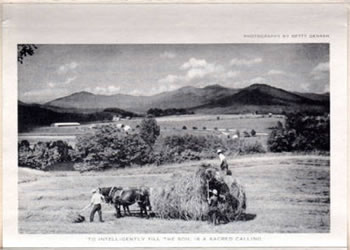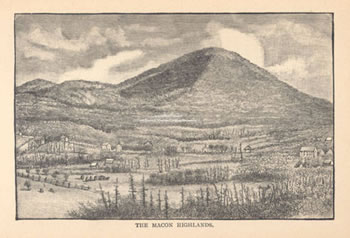Lesson Plans:
Economic Change
Grades/Subject: 8-11 History of N.C., U.S. History, Economics
Related Subjects: Art
Learning Outcomes:
- Students will develop an understanding of the changing nature of the economy of western North Carolina during the Craft Revival.
- Students will identify the industries affecting the farmers of southern Appalachia.
- Students will evaluate the elements of industrial growth that Revival leaders reacted to.
- Students will evaluate material artifacts as historical evidence.
Teacher Preparation:
This lesson can be completed in two block schedule days or four 45 minute class periods.
Teacher preparation time will include exploring the Craft Revival website, particularly the profiles of Revival leaders in “The People” section and the Revival in Context and the Southern Highlands sections of the Story. The instructor will also need to explore the historical census search options from the University of Virginia and define the searches that students will conduct.
Materials/Resources:
Poster board and other materials for creating visuals (markers, magazines, scissors, glue, etc.).
Procedure:
1. Students will explore the Craft Revival wand identify five objects/images/photos that they feel are representative of the primary culture and economy of western North Carolina at the time of the Craft Revival. An example may be a picture of a loom on the porch of a cabin. Students will explain how this photograph represents the economic lifestyle of the region. Or, a student may select a product to explain how they believe this object is representative of the area’s economic situation.
2. Students will write a brief explanation describing the relevance of each of these objects/images to what they believe is the economic basis of this region.
3. Along with consultation with the instructor, students will choose the one object/image that they feel is the best representation of western North Carolina’s economy and discuss it in greater detail in a journal entry or short essay. The focus of their writing will answer the question “What does this object or photograph tell us about western North Carolina’s economy?” Other questions for the student to consider include the following: How was this object made and what is the significance of that practice? What was the function/purpose of the object/activity? Does the object/activity reveal any sort of cultural or economic change taking place within western North Carolina communities?
The expectation is that students will describe an image of the southern Appalachians as a backwards/isolated agricultural region. This is partly due to the “story” that the images and objects from the Craft Revival tell. Agriculture was a huge part of the economy, but it was not the sole economic means in this era. This would be an excellent opportunity to discuss historiography with students. As the Craft Revival leaders had a particular end in mind (the preservation of a pre-industrial society that they felt was beneficial to the people of Appalachia), the products and images produced under their direction perpetuated the story they wanted to tell. Students can wrestle with whether this was actually representative of the area or a construct of the middle class urban reformers.
4. Have students analyze the following website: http://fisher.lib.virginia.edu/collections/stats/histcensus. This is a fairly comprehensive census search tool that allows for searches according to year as well as categorical searches. The instructor will need to look at the site before class to gain a familiarity with the search options and decide which search categories to utilize. Have students identify counties in western North Carolina and conduct searches for agricultural and manufacturing statistics for these counties. The instructor will need to define the searches students will conduct. Excellent options include the decrease in small farms at the expense of large concentrations of agricultural centers. This mirrors the national trend of the squeeze put on small time farmers. Another option is the growth of extractive industries in mountain and piedmont counties. As farming was less productive, many mountain families went to work in manufacturing facilities. Another option is a search for the number of wage laborers throughout the period.
5. Students will design a “visual web” that shows the representative nature of the object/image/activity chosen from the website. This visual will display the chosen item (which will be related to agricultural work or lifestyle) at the center of a web. They will then show branches out to a variety of other related activities with the student providing a visual representation of these activities. Taken as a whole, this visual web should provide a comprehensive understanding of the workings of the economy of western North Carolina during the Craft Revival. These branches will relate the processes examined in the historical census searches (manufacturing, extractive industries like mining/forestry, etc.). The instructor may wish to lead a discussion of the different industries moving into the area and other factors that affected the number of small family farms.

Assessment:
- Photo/object selection with explanations.
- Journal entry
- Visual Web
- Test (information from this lesson may be incorporated into a unit test).
Comments:
This lesson can easily be adapted to other states of the southern Appalachians. Historical census searches can be conducted by state and further broken down by county. Instructors may wish to highlight coal mining areas of Kentucky or other developments.
North Carolina Curriculum Alignment:
- NC History 1.01, 5.01
- US History 7.04
Bibliography:
- Becker, Jane S. Selling Tradition: Appalachia and the Construction of an American Folk, 1930-1940. Chapel Hill: University of North Carolina Press, 1998.
- Cobb, James. The Selling of the South: The Southern Crusade for Industrial Development. Baton Rouge: Louisiana State University Press, 1982
- Flamming, Douglas. Creating the Modern South: Millhands and Managers in Dalton Georgia, 1884-1984. Chapel Hill: University of North Carolina Pres, 1992.
- Patrick Velde





